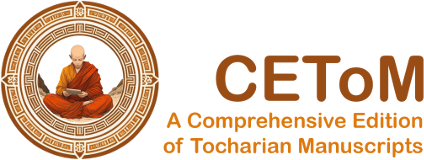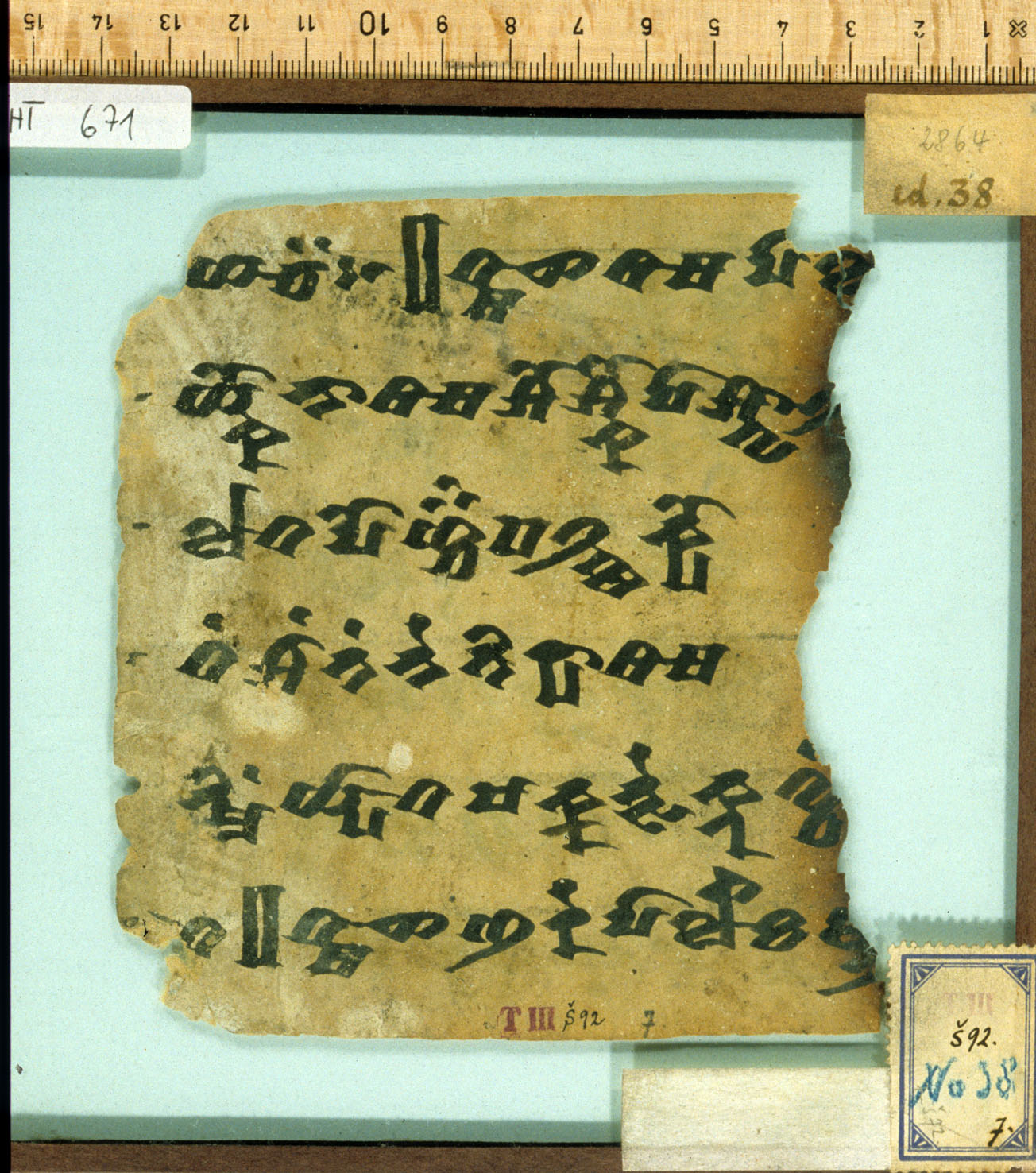A 38
| Known as: | A 38; THT 671 |
|---|---|
| Cite this page as: | Gerd Carling; Georges-Jean Pinault; Fanny Meunier; Michaël Peyrot. "A 38". In A Comprehensive Edition of Tocharian Manuscripts (CEToM). Created and maintained by Melanie Malzahn, Martin Braun, Hannes A. Fellner, and Bernhard Koller. https://cetom.univie.ac.at/?m-a38 (accessed 13 Jul. 2025). |
Edition | |
| Editor: | Gerd Carling; Georges-Jean Pinault; Fanny Meunier; Michaël Peyrot |
| Date of online publication: | 2013-10-02 |
Provenience | |
| Main find spot: | Shorchuk |
| Specific find spot: | Stadthöhle |
| Expedition code: | T III Š 92.07 |
| Collection: | Berlin Turfan Collection |
Language and Script | |
| Language: | TA |
| Script: | classical |
Text contents | |
| Title of the work: | Unknown Avadāna |
| Passage: | Remorse of an animal killer |
| Text genre: | Literary |
| Text subgenre: | Jātaka/Avadāna |
| Verse/Prose: | prose; verse |
Object | |
| Manuscript: | A 1-54 |
| Preceding fragment: | A 37 |
| Material: | ink on paper |
| Form: | Poṭhī |
| Number of lines: | 6 |
Images
Images from idp.bbaw.de by courtesy of the International Dunhuang Project Berlin, the Berlin-Brandenburgische Akademie der Wissenschaften, and the Staatsbibliothek zu Berlin – Orientabteilung.
Transliteration
(continues from A 37)
| lf | 30 9 |
|---|---|
| a1 | ya¯ ¯cä : 1 || tma¯ ¯s̝ sa¯ ¯m pā l· /// |
| a2 | yko nā sa¯ ¯m śo śko ṣā śwā¯ ¯l /// |
| a3 | la¯ ¯t po ñcäṃ pa ltsa kyo /// |
| a4 | taṃ śāṃ taṃ ne ti ryā sa¯ ¯m /// |
| a5 | nmiṃ ypā¯ ¯t ṣa kka tse knu wcaṃ /// |
| a6 | ¯t || tma¯ ¯s̝ ña re pā li¯ ¯k ā /// |
| b1 | ¯s mo trā lu rye s̝aṃ klaṃ klyo s̝a /// |
| b2 | ī me yo ptā ñka tka ṣṣiṃ o /// |
| b3 | nyo ca mi ptā ñä ktaṃ tso /// |
| b4 | ñi ca mi we wñu¯ ¯nt na /// |
| b5 | ¯s̝ tsa lpa rtā pā tri śñä kci /// |
| b6 | śo ṣyaṃ kā tklu ne ko spreṃ [k]· /// |
Transcription
(continues from A 37)
| lf | 30-9 |
| a1 | n1n2 yac : 1 ॥ tmäṣ säm pāl(at) /// |
|---|---|
| a2 | ykonā säm śoś koṣā śwāl /// (pā)¬ |
| a3 | latn3 poñcäṃ pältsäkyo /// |
| a4 | n4 °täṃśā-ṃ taṃne tiryā säm /// (o)¬ |
| a5 | nmiṃ ypāt ṣakkatsek nu wcaṃ /// |
| a6 | °t ॥ tmäṣ ñare-pālik ā /// |
| b1 | n5n6 °s motr-ālur yeṣ-äṃ klaṃ klyoṣä /// |
| b2 | īmeyo ptāñkät käṣṣiṃ o /// |
| b3 | n7 °nyo cami ptāñäktaṃ tso(pats) /// |
| b4 | ñi cami wewñunt na /// (saṃsārä)¬ |
| b5 | ṣ tsalpar tāpātriś ñäkci /// (ārki)¬ |
| b6 | śoṣyaṃ kātklune kospreṃ k· /// |
Translation
(continues from A 37)
| a1 | ... towards ... Then he praised ... |
|---|---|
| a2 | ... by day he killed sheep as food ... |
| a2+ | ... he praised ... with [his] whole mind ... |
| a4 | ... arose (?) to him. In this way he ... |
| a4+ | ... he felt remorse. |
| a5 | But actually (for a) second (time?) ... |
| a6 | ... || Then the guardian of hell ... |
| b1 | ... his incapacity of greenness went [away]. Hearing (?) the sound ... |
| b2 | ... with the idea ... the Buddha, the teacher ... |
| b3 | ... with ... great (love?) towards the Buddha (arose?) to him. |
| b4 | ... were spoken by him ... |
| b4+ | ... were redeemed from (saṃsāra). |
| b5 | ... of the trayastriṃśa gods ... |
| b5+ | ... rising in the world. |
| b6 | How much ... |
Commentary
Remarks
| Transcription and translation are based on Carling et al. 2009. | |
| Transcription and references have been transferred from the "Text and Reference Database of the Tocharian A Language" (Gerd Carling Lund University) (funded by the Bank of Sweden Tercentenary Foundation and SCAS). |
Philological commentary
| n1 | yac: possibly the 2pl.prs. of yäp- 'do', or an allative. This is the end of the strophe in the meñameññaṃ tune that begins in A 37 b4. |
|---|---|
| n2 | pāl(at): if correctly restored, the object apparently followed the verb. |
| n3 | (pā)lat: theoretically, other possibilities are ālat 'kept away' and wālat 'covered'. |
| n4 | täṃśā-ṃ: certainly a 1sg. or 3sg. ipf. of a nasal present of a verb with a root in tkā with a 3sg. pronoun suffix. Possible verbs are kātkā- 'arise', kätkā- 'cross', putkā- 'divide', lotkā- 'turn', rutkā- 'remove', lātkā- 'cut off', wrātkā- 'prepare (?)'. |
| n5 | motr-ālur: literally probably 'keeping away greenness', seems to be a calque on Skt. abhavya haritatvāya 'incapable of greenness' (see BhīKvāc 23b5 Ridding and de La Vallée Poussin 1920: 136). |
| n6 | klyoṣä: may be a gerund klyoṣä(l), less likely a 3sg.sbj. klyoṣä(ṣ). |
| n7 | tso(pats): cf. A 277 b2 (tso)pats tuṅkyo. |
References
Online access
Edition
Sieg and Siegling 1921: 24; Sieg and Siegling 1921 p. 24
Translations
Hackstein 1995: a2 (54); Thomas 1957: a2 (72)
Bibliography
Carling, Gerd, Georges-Jean Pinault, and Werner Winter. 2009. A dictionary and thesaurus of Tocharian A. Volume 1: Letters a-j. Wiesbaden: Harrassowitz.
Hackstein, Olav. 1995. Untersuchungen zu den sigmatischen Präsensstammbildungen des Tocharischen. HS Erg.-Heft 38. Göttingen: Vandenhoeck & Ruprecht.
“The International Dunhuang Project: The Silk Road Online.” n.d. http://idp.bl.uk.
Ridding and de La Vallée Poussin 1920
Ridding, Caroline Mary, and Louis de La Vallée Poussin. 1920. “A Fragment of the Sanskrit Vinaya. Bhiksunikarmavacana.” Bulletin of the School of Oriental Studies 1, Issue 3: 123–43.
Sieg, Emil, and Wilhelm Siegling. 1921. Tocharische Sprachreste, I. Band. Die Texte. A. Transcription. Berlin/Leipzig: de Gruyter.
Sieg, Emil, and Wilhelm Siegling. 1921. Tocharische Sprachreste, I. Band. Die Texte. A. Transcription. Personal annotated copy of Wilhelm Siegling. Scanned by Douglas Q. Adams with the technical assistance of Michael Tarabulski and Kevin Dobbins. Berlin/Leipzig: de Gruyter.
Thomas, Werner. 1957. Der Gebrauch der Vergangenheitstempora im Tocharischen. Wiesbaden: Harrassowitz.
Gippert, Jost, Katharina Kupfer, Christiane Schaefer, and Tatsushi Tamai. n.d. “Thesaurus Indogermanischer Text- und Sprachmaterialien (TITUS): Tocharian Manuscripts from the Berlin Turfan Collection.” http://titus.fkidg1.uni-frankfurt.de/texte/tocharic/thtframe.htm.




